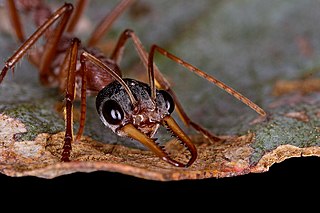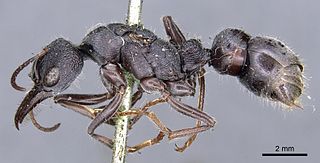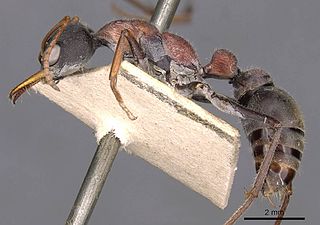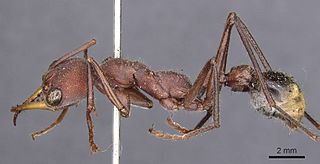
Myrmecia is a genus of ants first established by Danish zoologist Johan Christian Fabricius in 1804. The genus is a member of the subfamily Myrmeciinae of the family Formicidae. Myrmecia is a large genus of ants, comprising at least 93 species that are found throughout Australia and its coastal islands, while a single species is only known from New Caledonia. One species has been introduced out of its natural distribution and was found in New Zealand in 1940, but the ant was last seen in 1981. These ants are commonly known as bull ants, bulldog ants or jack jumper ants, and are also associated with many other common names. They are characterized by their extreme aggressiveness, ferocity, and painful stings. Some species are known for the jumping behavior they exhibit when agitated.

The jack jumper ant, also known as the jack jumper, jumping jack, hopper ant, or jumper ant, is a species of venomous ant native to Australia. Most frequently found in Tasmania and southeast mainland Australia, it is a member of the genus Myrmecia, subfamily Myrmeciinae, and was formally described and named by British entomologist Frederick Smith in 1858. This species is known for its ability to jump long distances. These ants are large; workers and males are about the same size: 12 to 14 mm for workers, and 11 to 12 mm for males. The queen measures roughly 14 to 16 mm long and is similar in appearance to workers, whereas males are identifiable by their perceptibly smaller mandibles.

Myrmecia nigriceps, also known as the black-headed bull ant, is a species of ant endemic to Australia. A member of the genus Myrmecia in the subfamily Myrmeciinae, it was first described by Austrian entomologist Gustav Mayr in 1862. These ants are large, varying from 19 to 23 millimetres in length. However, colonies contain workers that are much smaller, usually half the size of normal workers. The queens are the largest while the males are the smallest, which can be easily identified due to their small mandibles.

Myrmecia aberrans is an Australian bull ant of the genus Myrmecia. It is mostly spotted in South Australia and the states surroundings. The species of the bull ant was first described in 1900. The average length is around 12 millimetres. M. aberrans ants are commonly known as "wide jawed bull ants".

Myrmecia infima is an Australian ant species of the genus Myrmecia. First described in 1900 by Auguste-Henri Forel, Myrmecia infima are frequently seen in the western regions of Australia.

Myrmecia pyriformis, also known as the bull ant or inch ant, is an Australian ant. Myrmecia pyriformis belongs to the genus Myrmecia. It is abundant in many major cities of Australia, but mostly spotted in the eastern states. The species is of a similar appearance to the Myrmecia forficata.

Myrmecia fulviculis, the toothless bullant, is an Australian ant which belongs to the genus Myrmecia. This species is native to Australia and is usually distributed along the coastlines of New South Wales and Queensland.

Myrmecia rugosa is an Australian ant which belongs to the genus Myrmecia. This species is native to Australia. Their distribution in Australia is nationwide but are not common in the northern regions of Australia.

Myrmecia harderi is an Australian bull ant species which is part of the genus Myrmecia. They are native to Australia. They are mainly distributed in New South Wales, and some parts of Victoria, South Australia, and Queensland.
Myrmecia nigra is an Australian ant which belongs to the genus Myrmecia. This species is native to Australia and is commonly distributed in Western Australia, notably in Perth.

Myrmecia gilberti is an Australian ant which belongs to the genus Myrmecia. This species is native to Australia. This species is distributed throughout all of the eastern states and regions of Australia.

Myrmecia minuscula is an Australian ant which belongs to the genus Myrmecia. This species is native to Australia. They are distributed in the state of Queensland. They were described by Forel in 1915.

Myrmecia mjobergi is an Australian ant which belongs to the genus Myrmecia. This species is native to Australia. They are heavily distributed in Queensland, and are also distributed in the several other states. They were described by Auguste-Henri Forel in 1915.

Myrmecia chasei is an Australian ant which belongs to the genus Myrmecia. This species is native to Australia. The Myrmecia chasei has a large presence and distribution in the south-eastern areas of Western Australia.

Myrmecia erecta is an Australian bull ant species, a part of the genus Myrmecia. They are endemic to Australia. They are mainly distributed in South Australia and the surrounding areas of the state.

Myrmecia froggatti is an Australian ant which belongs to the genus Myrmecia. This species is endemic to Australia. This species is distributed throughout all areas of New South Wales and elsewhere up north and south.

Myrmecia athertonensis is an Australian ant which belongs to the genus Myrmecia. This species is endemic to Australia. They are commonly spotted in the north of Queensland. It was described by Forel in 1915.

Myrmecia michaelseni is an Australian ant which belongs to the genus Myrmecia. This species is native to Australia. They are mostly distributed and studied in Western Australia.
















